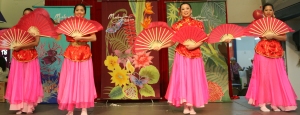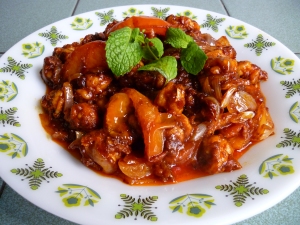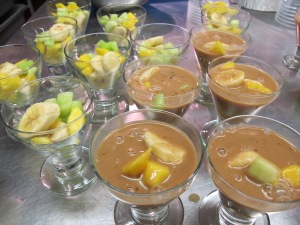Happy Chinese New Year !
Gong Hee Fat Choy to my Chinese friends and readers!
Wishing To all my Chinese friends and colleagues…Gong Hee Fatt Choy! A Very Happy New Year! Chinese New Year begins this year on January 31st…and it is the year of the horse! So if you are born in the years, 1942, 1954, 1966, 1978, 1990, 2002 the horoscope says you are popular, charming, cheerful and talented, perceptive and manage money well. And independent thinking, like to entertain, and skillful with your hands. But you can sometimes talk too much, rarely want to hear other’s advise and…at times weak with the opposite sex…ha! Compatible signs are tiger, dog and sheep. Sounds like a good sign! This year we may tend to overspend as the Chinese horoscope says, so we all have to be careful which isn’t easy for me with my travels! Enjoy and as for us, we will be going to my friend, Karen’s home to celebrate the evening with her and her family and savor her delicious steamboat meal!
Chinese New Year from Flavors of Malaysia Cookbook, Chapter 11, page 266
Chinese New Year, also referred to as Lunar New Year, is the most important celebration for Chinese and Chinese Peranakans in Malaysia. It begins on the first day of the first lunar month in the Chinese calendar and ends on the fifteenth day, so is usually observed in January or February.
On the eve, there is a family reunion dinner when spirits are appeased and food offerings are made to gods, including Kuan Yin, the goddess of Mercy. The married and family elders give unmarried youngsters ang pow, red packets that hold gifts of money. Homes are decorated with oranges, plum blossoms, and kumquat trees for good luck. Firecrackers are exploded to ward off evil spirits. Non-Chinese friends often pay a visit and offer greetings of gong hee fat choy. On the fifteenth night of Chinese New Year, which is called Chap Goh Meh, unmarried women throw oranges into the sea to wish for prospective good husbands and celebrate by eating rice dumplings. New Year celebrations end on the fifteenth day with Shang Yuan Jie, the festival that honors the Lords of Heaven, Earth, and Water.
On New Years’ Eve, foods that symbolize long life, joy, togetherness, children, and prosperity are served. Buddha’s Delight (vegetarian dish), steamed whole fish (signifying abundance), curried noodles (for longevity), sticky rice (signifying sustenance), egg rolls (for wealth), eggs (for fertility), sweet sesame seed balls, turnip cakes, and fruits are served. Vegetarian and fish dishes are prepared on the first day of the New Year as slaughtering animals is considered bad luck. So spicy sweet shrimp (symbolizing happiness) and fish dishes are popular.
Depending on the homes, New Year’s day meal may consist of popiah, shark fin soup, fried rice in lotus leaf, roast chicken, sesame and honey chicken, fragrant duck, braised Chinese mustard greens with seaweed, kailan with crabmeat sauce, and boiled dumplings. Hainanese chicken rice served with a light chicken broth, sesame-scented rice, and a chile ginger dip is a traditional meal served in many homes. Sweets and cakes are essential for the New Year, including almond cookies, pineapple tarts, water chestnut cake, semolina cake, peanut puffs, and butter cookies. Also during this time, a traditional household offers candy, honey, and sticky rice cake to the House Gods or Deities (protectors of the home) and ancestors.
Chinese Peranakans (Baba-Nonyas) also celebrate the Lunar New Year. Although of a mixed Chinese and Malay heritage, they identify themselves as Chinese, observing their many festivities and religious and ancestral rites. They speak Malay and the women dress in Malay attire, but they have remained Chinese, retaining their “traditional” Hokkien customs. But unlike the Chinese, their foods have a strong Malay influence, prepared with chilies, rempah (spice pastes), spices, lemongrass, coconut milk, and belacan (dried shrimp paste). Following their Chinese identity, they prepare and serve foods based on their symbolism. Their choice of ingredients and dishes for festivities derives from Chinese traditions and the concept of yin and yang. Some of their festive dishes include chicken curry; chap chye (mixed vegetables with mung bean noodles); inchee kabin (spicy fried chicken); ayam sioh (tamarind coriander chicken); nasi lemak (coconut-infused rice); and spicy laksas with fiery sambal condiments.
Every Nonya household offers a great variety of delectable kuehs and sweets. Kueh kapit (love letters), seri muka (glutinous rice custard), kueh lapis (layered custard), kueh kosui (steamed rice custard), and kueh bangkit (snow-white arrowroot flour cookies) are some they enjoy. For Chap Goh Meh, the fifteenth and final day of the Lunar New Year period, Nonyas enjoy pengat, a sweet porridge, prepared with sweet potatoes, taro, and/or bananas flavored with coconut milk and pandan leaf, a true reflection of their mixed heritage.
For Chinese New Year, generations of a family get together and celebrate for two weeks. Seafood dishes are important, as they are symbolic of prosperity and good luck. Serving fish (yee) symbolizes always having extra money in your hands, shrimp (ha) symbolizes happiness and laughter, and oysters (ho) bring good business.
During one Chinese New Year, at the home of one of my schoolmates, Adeline, I had wonderful spicy, sweet, and almost pinkish jumbo shrimps with shells on. Many a Chinese New Year I would visit her home, but through the years of studying and living overseas, I lost touch with her. I last saw her was at her home in Petaling Jaya just before they emigrated to New Zealand when our two daughters were so very young. My memory of her and our mutual friends at Bukit Nanas Convent School in Kuala Lumpur has not faded, as I still treasure those wonderful times together. I created this shrimp dish that reminds me of Adeline’s open house Chinese New Year celebrations and the wonderful times with my friends.
Below are 2 dishes from my Flavors of Malaysia cookbook. They are prepared during Chinese New year, by Chinese and Nonyas in Malaysia.
Spicy Sweet Shrimp, Chp 11, page 286
Makes 4 to 5 servings
Ingredients
1 tablespoon cooking oil
1 tablespoon chopped garlic cloves
1 heaping tablespoon chopped fresh ginger
Heaping ¼ cup sliced or diced shallots or onions
1 fresh red chile (Fresno, jalapeno, cayenne, Thai, or cherry), sliced
3 tablespoons tomato puree, or 2 tablespoons tomato paste, or 6 tablespoons tomato sauce
½ to 1 teaspoon sugar
1 teaspoon Worcestershire sauce
1 teaspoon cooking wine
1 pound (about 2 heaping cups) shelled and deveined shrimp, with tails intact
1 teaspoon roasted sesame oil
1 teaspoon cornstarch mixed with 2 tablespoons water
Garnish
2 tablespoons sliced spring onions or Chinese chives (kuchai )
DIRECTIONS:
- Heat oil in a skillet or wok and sauté garlic and ginger for about ½ to 1 minute; add shallots or onions and sauté another 1 to 2 minutes.
- Add chile and sauté ½ minute, then add 1 cup water, tomato puree, paste, or sauce, sugar, Worcestershire sauce, and cooking wine, and stir for about 1 to 2 minutes.
- Add shrimp and sauté for 3 minutes, till cooked.
- Add sesame oil, stir for ½ minute, then add cornstarch paste and blend well for about 1 minute.
- Garnish with spring onions or Chinese chives.
Bananas in a Sweet Pandan Sauce/Pengat Pisang, Chp 10, page 253
Makes 5 servings
Pengat pisang is a traditional sweet snack or dessert and usually has sliced pisang raja (or King bananas, sweet small bananas) simmered in coconut milk with sago pearls, palm sugar (gula Melaka), and pandan leaves. Malaysians enjoy different fruit-based and tuber-based pengats using durian, jackfruit, yam, tapioca, or pumpkin.
Nonyas (of mixed Malay and Chinese heritage) add steamed sweet potatoes and taro to the pandan scented coconut milk broth. They usually prepare it for ceremonial occasions and especially enjoy it on the fifteenth day of their New Year, during Chap Goh Meh festival. Pengat pisang can be served warm or chilled.
I remember coming home one day after my home economics class at the age of 7 so excited for my mom to try my version of pengkat pisang using taro and bananas. Mom of course gave a big smile as she ate it and was full of praise for my creation. On one of my more recent trips to Malacca during a hot humid evening, I stopped by a small Nonya café in the historic Baba- Nonya area and enjoyed a bowl of sweet pengat pisang. In my recipe below, I reduce the sugar and coconut milk and add aromatic cardamom and diced mango. You can add melon and or other fruits to make a mixed fruit pengat pisang. Some cooks also use ripe plantains and simmer it longer.
INGREDIENTS
1 tablespoon sago or small tapioca pearls
1 cup unsweetened coconut milk
¼ cup thinly sliced or chopped palm sugar or dark brown sugar
2 fresh or frozen and thawed pandan leaves, tined with a fork and tied into a knot
3 green cardamom pods, crushed, seeds removed, and pounded or ground, or ⅛ teaspoon ground cardamom
1/8 to ¼ teaspoon salt
5 (14 ounces) ripe peeled bananas, sliced on the diagonal into ½-inch pieces (slice just before cooking or serving to prevent discoloration)
1 cup (5 ounces) peeled and cubed ripe mangoes or honeydew melon (½-inch cubes)
DIRECTIONS:
1. Place sago or tapioca pearls in a sieve and rinse under running water, or soak in water for about 15 minutes and then drain (this is to remove excess or adhering starch to separate pearls).
2. In a pot, place the sago or tapioca pearls, 1½ cups water, coconut milk, sugar, pandan leaves, cardamom, and salt and bring to a boil stirring frequently.
3. Lower heat and simmer for about 8 minutes, till sago or tapioca pearls become translucent and swollen.
4. Add bananas and mangoes or melon and simmer for about 1 to 2 minutes, taking care not to let bananas get mushy. (Or place bananas and mango or melon in a bowl and pour sauce over.) Discard pandan leaves before serving.
Serve with tea or coffee, teh masala or teh tarik .




Your art and mastery are awesome ..BRAVO !!
Happy Chinese New Year .. Year of the Snake .
maria
Mucho gracias Maria. me gusta escribo acerca de comida y cultura. Feliz de ano nuevo China!
sushee